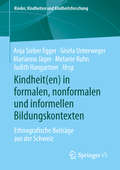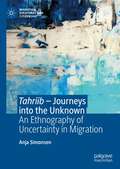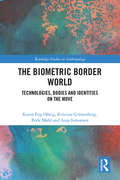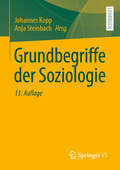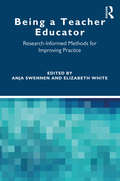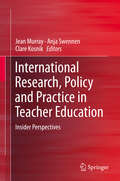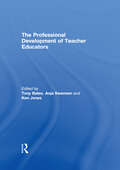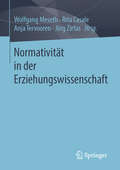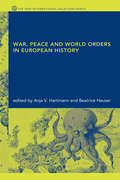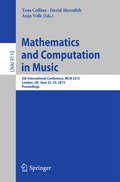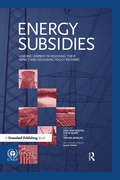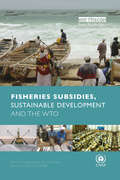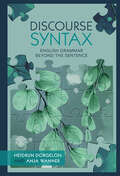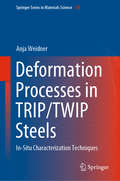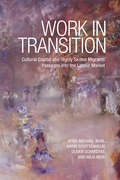- Table View
- List View
Kindheit: Ethnografische Beiträge aus der Schweiz (Kinder, Kindheiten und Kindheitsforschung #20)
by Judith Hangartner Melanie Kuhn Anja Sieber Egger Gisela Unterweger Marianna JägerDer Band versammelt aktuelle ethnografische Studien zu Kindheiten in formalen, nonformalen und informellen Bildungskontexten in der Schweiz. Bei unterschiedlichen disziplinären Zugängen, die spezifisch für die heterogene ethnografische Forschungslandschaft in der Schweiz sind, teilen alle Beiträge dieses Bandes zwei kindheitstheoretische Prämissen: Sie begreifen ‚Kindheit‘ erstens als ein interaktiv, praktisch oder diskursiv hervorgebrachtes Phänomen, das wesentlich durch institutionelle Arrangements geprägt und bedingt ist und verstehen dabei zweitens Bildung als integralen Teil der gesellschaftlichen Institutionalisierung von Kindheit.
Tahriib – Journeys into the Unknown: An Ethnography of Uncertainty in Migration (Migration, Diasporas and Citizenship)
by Anja SimonsenThis book offers an innovative approach to migration by exploring Somali youths’ tahriib, their ‘journey into the unknown’. When young Somali men and women refer to the ‘unknown’, they recognize the uncertainty of their journeys. This uncertainty is partly due to the laws and policies that restrict the right to cross national boundaries and define their movements as illegal. Based on fieldwork conducted with Somali youth, mainly from Somaliland, the book details their perceptions of the journey and their practices on the way. The author shows how they position themselves in a constantly changing world before and during the so-called migration crisis that began in 2015. A vital part of tahriib is the constant search for information on possible routes ahead, a search that intensifies as the journey progresses. Specific policy responses, such as biometric registration, influence practices of gathering and sharing information. They have implications for the creation and shattering of hope and the experience of time en route. The book demonstrates that tahriib is ultimately about spending one’s time wisely and about creating and maintaining hope in what may seem hopeless situations.
The Biometric Border World: Technology, Bodies and Identities on the Move (Routledge Studies in Anthropology)
by Karen Fog Olwig Kristina Grünenberg Perle Møhl Anja SimonsenSince the 1990s, biometric border control has attained key importance throughout Europe. Employing digital images of, for example, fingerprints, DNA, bones, faces or irises, biometric technologies use bodies to identify, categorize and regulate individuals’ cross-border movements. Based on innovative collaborative fieldwork, this book examines how biometrics are developed, put to use and negotiated in key European border sites. It analyses the disparate ways in which the technologies are applied, perceived and experienced by border control agents and others managing the cross-border flow of people, by scientists and developers engaged in making the technologies, and by migrants and non-government organizations attempting to manoeuvre in the complicated and often-unpredictable systems of technological control. Biometric technologies are promoted by national and supranational authorities and industry as scientifically exact and neutral methods of identification and verification, and as an infallible solution to security threats. The ethnographic case studies in this volume demonstrate, however, that the technologies are, in fact, characterized by considerable ambiguity and uncertainty and subject to substantial subjective interpretation, translation and brokering with different implications for migrants, border guards, researchers and other actors engaged in the border world.
Nachhaltiges Wachstum im Mittelstand: Ein Praxisleitfaden für Geschäftsführer:innen
by Daniel B. Werner Olof von Lindequist Anja Sinz Raphael Herkommer Helen KuhnleDieses Buch zeigt praxisnah auf, wie Geschäftsführer:innen, Entscheidungsträger:innen und Führungskräfte das Wachstum in ihren Unternehmen nachhaltig fördern können. Die Autoren beschreiben anhand einer Wachstumsgleichung fünf Faktoren für organisationales Wachstum, die sich in eine strategische und eine kulturelle Dimension unterteilen. Dabei werden die Faktoren beider Dimensionen gleichermaßen berücksichtigt, um erfolgreich und nachhaltig zu wachsen.Wertvolle Tipps, Übungen und Tools unterstützen bei der Umsetzung in die Praxis und helfen den Leser:innen dabei, konkrete Wachstumsbremsen im eigenen Unternehmen zu identifizieren und Handlungsmaßnahmen sowie Ziele abzuleiten.
Familiensoziologie: Eine kompakte Einführung (Studienskripten zur Soziologie)
by Johannes Kopp Karsten Hank Paul B. Hill Anja SteinbachDer Band gibt einen fundierten Einblick in die Familiensoziologie. Dabei werden zunächst die historischen und ethnologischen Variationen der Formen familialen Lebens thematisiert und die wichtigsten Theorietraditionen der Familiensoziologie vorgestellt. Für die zentralen Gegenstandsbereiche - etwa Partnerwahl, Heiratsverhalten, innerfamiliale Interaktion, Fertilität, Familienformen sowie Trennung und Scheidung - wird der theoretische und empirische Stand der Forschung vorgestellt und diskutiert.
Grundbegriffe der Soziologie
by Johannes Kopp Anja SteinbachIn dem Band wird das Feld der Soziologie anhand von über 100 Grundbegriffen beleuchtet. Neben der begrifflichen Klärung wird dabei auch ein Überblick über die theoretischen Grundlagen der Soziologie und eine verlässliche Orientierung und Einführung geboten. Es wird ein grundlegendes und breites Verständnis der Soziologie und ihrer Anwendungsfelder vermittelt.
Handbuch Familiensoziologie
by Karsten Hank Anja Steinbach Oliver Arránz BeckerDieser Band bietet einen umfassenden Einblick in die große thematische Breite und Tiefe der familiensoziologischen Forschung. Dabei geht es um die Konstanten und Differenzierungen des familialen Lebens in den verschiedensten Regionen der Welt sowie die unterschiedlichen methodischen und theoretischen Ansatzpunkte in der Familienforschung. Schließlich wird eine Vielzahl familialer und sozialstruktureller Fragestellungen einschließlich ihrer empirischen Fundierung aufgegriffen, referiert und kritisch kommentiert. Heiratsmarkt, Fertilität, Arbeitsteilung, Generationenbeziehungen, Trennung, Bildung, Mobilität, Familienpolitik und -recht sind nur einige Beispiele für den breiten thematischen Zugriff des vorliegenden Bandes, welcher in vier thematischen Abschnitten und dreiunddreißig Beiträgen systematisch das Feld der Familiensoziologie beschreibt.
200 Words to Help You Talk about Philosophy
by Anja SteinbauerHave you have ever felt at a disadvantage when joining in a conversation on a subject that you aren't confident about? If yes, this new book series is for you. Each book features definitions of two hundred words frequently used to describe and discuss a smart subject.200 Words to Help You Talk About Philosophy is designed to demystify jargon-based philosophic language and make you at ease holding a conversation on the topic. Philosophy can be baffling, as well as fascinating, to the best of us. Let Anja Steinbauer guide you through doubt, dialectic, Dao, and much more. The book is written with digestible text enabling a quick and easy understanding of various topics while broadening your philosophical vocabulary. 200 Words to Help You Talk About Philosophy is one of two new titles beginning a series of smart subjects, also including art, psychology, and music.
200 Words to Help You Talk about Philosophy
by Anja SteinbauerHave you have ever felt at a disadvantage when joining in a conversation on a subject that you aren't confident about? If yes, this new book series is for you. Each book features definitions of two hundred words frequently used to describe and discuss a smart subject.200 Words to Help You Talk About Philosophy is designed to demystify jargon-based philosophic language and make you at ease holding a conversation on the topic. Philosophy can be baffling, as well as fascinating, to the best of us. Let Anja Steinbauer guide you through doubt, dialectic, Dao, and much more. The book is written with digestible text enabling a quick and easy understanding of various topics while broadening your philosophical vocabulary. 200 Words to Help You Talk About Philosophy is one of two new titles beginning a series of smart subjects, also including art, psychology, and music.
Führen mit Präsenz
by Silke Strauß Anja StruchholzDie Fähigkeit zur Präsenz ist essenziell, um als Führungskraft erfolgreich zu agieren. Silke Strauß und Anja Struchholz wissen aus langjähriger Erfahrung in Geschäftsführung und Bühnenkunst, in der Führungskräfteentwicklung, dem Coaching und der Rekrutierung, wie Menschen ihre Anliegen erfolgreicher vertreten, andere damit besser erreichen und so wirksamer in ihren Rollen werden. Sie geben Führungskräften Instrumente und Denkwerkzeuge zur Hand, um den Herausforderungen von Führung in Zeiten agilen Managements mit Kompetenz und Gelassenheit zu begegnen und auf den Bühnen des Alltags Menschen zu bewegen. Mit ihrem Buch richten sich die Autorinnen an Führungskräfte aller Hierarchiestufen bis zur ersten Ebene, die ihre Führungspräsenz weiterentwickeln möchten.
Being a Teacher Educator: Research-Informed Methods for Improving Practice
by Elizabeth White Anja SwennenThis collection offers a timely and wide-ranging contribution to the research-informed improvement of the work of teacher educators. Drawing on original research studies conducted across a range of European countries, Canada, and Israel, contributors offer insight into not only questions of curriculum and programme development, research, and professional development, but also their day-to-day experience as teacher educators, student teachers, and mentors in schools. Themes explored include teaching and working with students, teacher educators as researchers, the partnership work of teacher educators, the professional development needs of teacher educators, professional development approaches for improving teacher education, and teacher educator empowerment. Arising from the international community of the Association for Teacher Education in Europe (ATEE), and drawing together theory and practice, this book offers a unique survey of the contributions of teacher educators and charts a path for future directions of the field.
International Research, Policy and Practice in Teacher Education: Insider Perspectives
by Jean Murray Clare Kosnik Anja SwennenThis unique book is an important source of information for all of those who educate future teachers and those who participate in teacher education as students, researchers, educators and policymakers. The volume also contributes to the international development of higher quality and research-led teacher education provision by providing clear evidence of policy impact. It draws on original research studies, conducted across eight countries in North America, Europe and Australia to analyse the impact of teacher education policy initiatives on ‘insiders’ in the fields, including education students, teacher educators and mentors in schools. In achieving this, the various chapters in the book analyse the commonalities and differentiations in the many policy reforms in teacher education currently being implemented by national governments. The book reveals some of the hidden consequences of these recent ‘reform’ efforts. It is also of use for leaders and policy makers in teacher education, providing them with insider perspectives from both theory and practice and making it possible for them to develop research-informed decisions that take into account the voices of insiders. Few texts have considered international policy trends alongside the impact they have had on significant stakeholder groups ‘inside’ teacher education. In redressing this omission, the book contributes to a better understanding of and improved practice of work in teacher education, both pre- and in-service.
The Professional Development of Teacher Educators
by Ken Jones Anja Swennen Tony BatesThis book makes a significant contribution to a hitherto much neglected area. The book brings together a wide range of papers on a scale rarely seen with a geographic spread that enhances our understanding of the complex journey undertaken by those who aspire to become teachers of teachers. The authors, from more than ten countries, use a variety of approaches including narrative/life history, self-study and empirical research to demonstrate the complexity of the transformative search by individuals to establish their professional identity as teacher educators. The book offers fundamental and thoughtful critiques of current policy, practice and examples of established structures specifically supporting the professional development of teacher educators that may well have a wider applicability. Many of the authors are active and leading persons in the international fields of teacher education and of professional development. The book considers: Becoming a teacher is recognised as a transformative search by individuals for their teaching identities. Becoming a teacher educator often involves a more complex and longer journey but, according to the many travel stories told here, one that can be a deeply satisfying experience. This book was published as a special issue of Professional Development in Education.
Malaria Immunology: Targeting the Surface of Infected Erythrocytes (Methods in Molecular Biology #2470)
by Anja Tatiana Ramstedt Jensen Lars HviidThis volume covers a broad range of methods, technologies, and protocols on malaria. Chapters detail research on collecting parasites in the field, single molecule-level analyses of adhesive interactions, and focused studies aiming at disrupting the devastating disease. Written in the format of the highly successful Methods in Molecular Biology series, each chapter includes an introduction to the topic, lists necessary materials and reagents, includes tips on troubleshooting and known pitfalls, and step-by-step, readily reproducible protocols. Authoritative and cutting-edge, Malaria Immunology: Targeting the Surface of Infected Erythrocytes aims to be a useful and practical guide to researches to help further their study in this field. Chapter Analysis of var gene transcription pattern using DBLα-tags [Chapter 14] is available open access under a Creative Commons Attribution 4.0 International License via link.springer.com.
Normativität in der Erziehungswissenschaft
by Anja Tervooren Jörg Zirfas Wolfgang Meseth Rita CasaleIn welchem Verhältnis steht die Erziehungswissenschaft zur Normativität pädagogischer Theorie und Praxis, aber auch zu den Erwartungen von Bildungspolitik und Bildungsplanung? Inwiefern versteht sie sich als engagierte oder distanzierte Forschung, die nicht nur Theoriebildung und empirische Forschung über Pädagogik vorantreiben, sondern auch in Bildungspolitik und pädagogische Praxis eingreifen will? Mit dem Thema Normativität behandelt das Buch einen zentralen Problemhorizont von Erziehung und Bildung, der in den vergangenen Jahren wieder stärker in den Fokus erziehungswissenschaftlicher Debatten gerückt ist. Die Beiträge diskutieren die Begründungsprobleme pädagogischer Sollensaussagen, sie fragen nach den Kriterien guten pädagogischen Handelns und untersuchen die Normativität der pädagogischen Praxis. Sie richten ihren Blick aber auch auf die normativen Implikationen der empirischen Forschung sowie des Selbstverständnisses der Erziehungswissenschaft als wissenschaftliche Disziplin.
Einflüsse der Dunklen Triade auf das Strategische Risikomanagement: Eine qualitative Analyse der Einflüsse von Narzissmus, Machiavellismus und Psychopathie (Forschungsreihe PHW)
by Anja ThalerInnerhalb dieses literaturbasierten Forschungsprojektes werden Einflüsse zum einen durch die Dunkle Triade und zum anderen aus dem strategischen Risikomanagement untersucht. Im Bereich der Dunklen Triade werden mithilfe des Five Factor Modells gemeinsame als auch unterschiedliche Einflüsse sowie Tendenzen von Narzissmus, Machiavellismus sowie Psychopathie ermittelt. Im Kontext des strategischen Risikomanagements werden Einflüsse organisatorischer und kultureller sowie kognitiver und emotionaler Aspekte analysiert. Während kognitive und emotionale Einflüsse eine direkte Einflussnahme auf das strategische Risikomanagement implizieren, sind demografische Einflüsse im Vergleich weniger aussagekräftig. Organisatorische Einflüsse können eine moderierende Rolle spielen und das Verhalten von Managern entsprechend verstärkend oder abschwächend gestalten, abhängig von den Rahmenbedingungen innerhalb der Unternehmung.
Zur Komplementarität des Denkens
by Anja TrebbinDie Forschung hat bisher vorrangig Gemeinsamkeiten und Differenzen der theoretischen Ansätze Foucaults und Bourdieus vergleichend nebeneinander gestellt. Ein derartig polarisierender Ansatz aber verbaut den Blick auf eine produktivere Herangehensweise: Foucault und Bourdieu sollten vielmehr komplementär aufeinander bezogen, die Unterschiede nicht als Gegensätze, sondern als Ergänzungen begriffen werden. Anja Trebbin zeigt, wie sich unter anderem Foucaults Analysen einzelner Machtpraktiken mit Bourdieus Untersuchungen sozialer Relationen zu einem Verfahren mit umfassendem Erkenntniswert verbinden lassen. Die Autorin lotet zum einen aus, inwiefern eine komplementäre Lesart neue Aspekte des Verhältnisses der Theorien Foucaults und Bourdieus sichtbar machen kann. Zum anderen zeigt sie, wie sich aus einer solchen Situierung beider Denker Anregungen für eine politische Praxis gewinnen lassen
War, Peace and World Orders in European History (New International Relations)
by Beatrice Heuser Anja V HartmannThis book explores a new way for students of International Relations to look at war, peace and world orders throughout European history. The contributors argue that the predominant 'realist' paradigm that focuses on states and their self-interest is not applicable to the largest period of European history, because states either did not exist or were only in the making. Instead, they argue, we have to look through the eyes of historical entities to see how they understood the world in which they lived, The authors use a wide range of case-studies, focusing on subjects as diverse as the ancient Greek concept of honour and persecution under Communist regimes during the Cold War to explore the ways in which people in different societies at different times perceived and felt about war and peace in the world around them.
Mathematics and Computation in Music
by David Meredith Tom Collins Anja VolkThis book constitutes the thoroughly refereed proceedings of the 5th International Conference on Mathematics and Computation in Music, MCM 2015, held in London, UK, in June 2015. The 24 full papers and 14 short papers presented were carefully reviewed and selected from 64 submissions. The papers feature research that combines mathematics or computation with music theory, music analysis, composition, and performance. They are organized in topical sections on notation and representation, music generation, patterns, performance, similarity and contrast, post-tonal music analysis, geometric approaches, deep learning, and scales.
Energy Subsidies: Lessons Learned in Assessing their Impact and Designing Policy Reforms
by Anja Von Moltke Klaus Töpfer Colin McKee Trevor MorganThe need to reform energy subsidies was one of the pressing issues highlighted at the World Summit on Sustainable Development. Many types of subsidy, especially those that encourage the production and use of fossil fuel, and other non-renewable forms of energy, are harmful to the environment. They can also have high financial and economic costs, and often only bring few benefits to the people for whom they are intended.Removing, reducing or restructuring such energy subsidies is helpful for the environment and the economy at the same time. Potential social costs in terms of employment in the conventional energy industry or reduced access to energy could be addressed by redirecting the money formerly spent on subsidies to income support, health, environment, education or regional development programmes.Of course, subsidies can have certain positive consequences, particularly where they are aimed at encouraging more sustainable energy production and use. Temporary support for renewable energy and energy-efficient technologies to overcome market barriers, and measures to improve poor or rural households' access to modern, commercial forms of energy, for instance, could be positive measures in support of sustainable development.Based on ground-breaking work undertaken by UNEP and the International Energy Agency, this book aims to raise awareness of the actual and potential impacts of energy subsidies and provide guidance to policy-makers on how to design and implement energy-subsidy reforms. It provides methodologies for analysing the impact of subsidies and their reform, and reviews experiences with energy subsidies in a number of countries and regions. Drawing on these case studies, it analyses the lessons learned as well as the policy implications, and provides guidance on how to overcome resistance to reform.The book provides an analytical framework which aims to set the scene for the detailed discussion of energy-subsidy issues at the country level. It considers how subsidies are defined, how they can be measured, how big they are and how their effects can be assessed. A more detailed discussion of methodological approaches to the assessment of the economic, environmental and social effects of subsidies and their reform is contained in the Annex.Chapters 3–11 of the book contain country case studies from contributing authors, which review various experiences and issues related to energy subsidies in selected countries, but do not strive for a common approach. They are organised along geographical lines, beginning with a review of energy subsidies generally in OECD countries. Case studies of energy subsidies in transition economies – the Czech and Slovak Republics (Chapter 4) and Russia (Chapter 5) – follow. Three studies of Asian countries focus on the costs of different types of energy subsidy: electricity subsidies in India (Chapter 6), oil subsidies in Indonesia (Chapter 7) and energy subsidies generally in Korea (Chapter 8). Chapter 9 reviews the effect of energy subsidies in Iran and suggests a pragmatic approach to reforming them. This is followed by an assessment of the LPG subsidy programme in Senegal (Chapter 10) and an analysis of the effects of removing coal and oil subsides in Chile (Chapter 11).Chapter 12 analyses the lessons learned from these case studies, focusing on the economic, environmental and social effects and their implications for policy. Finally, Chapter 13 discusses the implications of these findings and makes practical recommendations for designing and implementing policy reforms.This book will be essential for both practitioners and academics involved in the energy sector and for governments and policy-makers wishing to examine the reform of energy subsidies.
Fisheries Subsidies, Sustainable Development and the WTO
by Anja Von MoltkeThe fisheries sector is in crisis. Inappropriate subsidies to the fishing industry are a key factor responsible for worldwide fisheries depletion, overcapitalization and ecosystem degradation. There is an urgent need for an international mechanism to promote the appropriate restructuring of fisheries subsidies in order to create a more sustainable industry. In recent years the leading international forum charged with providing such a mechanism has been the World Trade Organization (WTO). This book explains why and how the reform of fisheries subsidies has become one of the most concrete and potentially successful international efforts to achieve global environmental, economic and developmental policy coherence. It describes the history and current status of the discussions at the WTO, drawing on UNEP's key documents and reflecting on the major issues. Accompanying the book is a CD-Rom containing full-text versions of the most important source material used in the publication. The book is aimed at a broad stakeholder audience, including policymakers in the fields of trade, fisheries, environmental economics and international environmental governance, as well as academics and others looking for an overview of the fisheries subsidies issue and an introduction to its technical components. Published with the United Nations Environment Programme (UNEP)
Discourse Syntax: English Grammar Beyond the Sentence
by Heidrun Dorgeloh Anja WannerDiscourse Syntax is the study of syntax that requires an understanding of the surrounding text and the overall discourse situation, including considerations of genre and modality. Using corpus data and insights from current research, this book is a comprehensive guide to this fast-developing field. It takes the reader 'beyond the sentence' to study grammatical phenomena, like word order variation, connectives, ellipsis, and complexity. It introduces core concepts of Discourse Syntax, integrating insights from corpus-based research and inviting the reader to reflect on research design decisions. Each chapter begins with a definition of learning outcomes, provides results from empirical articles, and enables readers to critically assess data visualization. Complete with helpful further reading recommendations as well as a range of exercises, it is geared towards intermediate to advanced students of English linguistics and it is also essential reading for anyone interested in this exciting, fast-moving discipline.
Deformation Processes in TRIP/TWIP Steels: In-Situ Characterization Techniques (Springer Series in Materials Science #295)
by Anja WeidnerThis book demonstrates the potential of novel in-situ experiments, performed on microscopic and macroscopic length scales, for investigating localized deformation processes in metallic materials, particularly their kinetics and the associated evolution of local strain fields. It features a broad methodological portfolio, spanning optical and electron microscopy, digital image correlation, infrared theromgraphy and acoustic emission testing, and particularly focuses on identifying the localized microscopic deformation processes in high-strength/high-ductility CrMnNi TRIP/TWIP (TRansformation Induced Plasticity/TWinning Induced Plasticity) steels. Presenting state-of-the art methodology applied to topical and pertinent problems in materials engineering, this book is a valuable resource for researchers and graduate students working in the field of plasticity and deformation of structural materials.
Deformation Processes in TRIP/TWIP Steels: In-situ Characterization Techniques (Springer Series In Materials Science Series #295)
by Anja WeidnerThis book demonstrates the potential of novel in-situ experiments, performed on microscopic and macroscopic length scales, for investigating localized deformation processes in metallic materials, particularly their kinetics and the associated evolution of local strain fields. It features a broad methodological portfolio, spanning optical and electron microscopy, digital image correlation, infrared theromgraphy and acoustic emission testing, and particularly focuses on identifying the localized microscopic deformation processes in high-strength/high-ductility CrMnNi TRIP/TWIP (TRansformation Induced Plasticity/TWinning Induced Plasticity) steels. Presenting state-of-the art methodology applied to topical and pertinent problems in materials engineering, this book is a valuable resource for researchers and graduate students working in the field of plasticity and deformation of structural materials.
Work in Transition
by Arnd-Michael Nohl Anja Weiss Oliver Schmidtke Karin SchittenhelmDespite the fact that many countries target highly skilled migrants for recruitment in the global labour market, few of those migrants are able to take full advantage of their educational and professional qualifications in their new homes. Work in Transition examines this paradox, using extended narrative interviews that focus on the role that cultural capital plays in the labour market.Comparing the migrant experience in Germany, Canada, and Turkey, Work in Transition shows how migrants develop their cultural capital in order to enter the workforce, as well as how failure to leverage that capital can lead to permanent exclusion from professional positions. Exposing the mechanisms that drive inclusion and exclusion for migrants from a transatlantic comparative perspective, this book provides a unique analytical approach to an increasingly important global issue.
